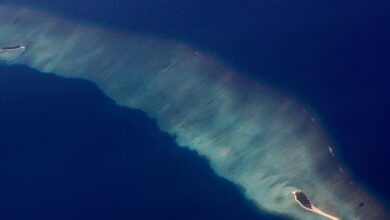Is it still possible for planes to disappear from the map ten years after MH370 happened?
“Good night. Three Seven Zero Malaysian.

Less than an hour had passed since Malaysia Airlines Flight 370 took off late on March 8, 2014, from Kuala Lumpur to Beijing, when those six words were the final ones spoken over the intercom. The aircraft vanished from radar displays used for air traffic control a few minutes later.
Almost as long as a Manhattan city block and height as a five-story structure, the massive Boeing Co. 777 airplane had somehow managed to blend into the bright night sky, going unnoticed. On board were 239 individuals.
Hundreds of miles off the western coast of Australia, the southern Indian Ocean is hostile. Subsequent search efforts scoured some of the deepest ocean floors in this hostile region, but they were unable to locate the main fuselage or any survivors or crew. Only a small portion of the 777’s 3 million parts washed up on the coast of east Africa years later.
You can get the Big Take podcast on Bloomberg Terminal, iHeart, Apple Podcasts, and Spotify. Go through the transcript.
With no mayday call, no identified flight route, and no debris, MH370 continues to be the greatest enigma in contemporary aviation. Even though the investigators had very little information, they were certain of one thing: an aircraft should never disappear in this manner again.
However, ten years later, years of regulation changes documenting the process show that bureaucracy, financial pressure, and a dispute over who should have final say over the cockpit have thwarted an industrywide attempt to rule out a similar scenario.
Recommendations made by Malaysian officials in the weeks after the accident for a crucial aircraft monitoring device were not followed through on. A doomed passenger airplane in a distant part of the world might stay concealed indefinitely, despite the industry saving hundreds of millions of dollars in equipment expenses because to a gap in aviation safety regulations the size of an ocean.
An extra safety measure led by the International Civil Aviation Organization suggested that new aircraft should broadcast their location at least once per minute if they were having problems, while search teams searched in vain for Malaysia Airlines Flight MH370. Giving authorities early notice of a tragedy in progress was the goal. Rescue crews would at least have a chance of finding the crash site if the jet went down later.
That hasn’t been the case in reality. There have been two delays to the one-minute tracking regulation. Originally scheduled to go into effect in January 2021, it will now start to take effect in January 2025. More than a dozen significant airlines from the US, Europe, the Middle East, and Asia were questioned by Bloomberg News on the proportion of their fleets that already comply with ICAO regulations. Few aircraft at the airlines that replied are in compliance.
As of September, Air France boasted more than 250 aircraft. Of them, seven aircraft, all Airbus SE A350s, met the required specifications. Japan Airlines Co. said that two of its 226 aircraft are fitted with the tracking device, while Korean Air Lines Co. claimed that three of its 159 aircraft are.
According to Hassan Shahidi, president and chief executive officer of the Flight Safety Foundation, a non-profit organization located in Virginia that advocates for aviation safety standards, the wait since MH370 disappeared has been intolerable. “This was a tragic event for which answers have been found. We must take this last action immediately,” Shahidi said.
In addition to being years behind schedule, the new tracking standard is exclusive to newly built aircraft. For the almost twenty thousand older aircraft that were still in operation as of last year, there is no need to add the necessary equipment. This implies that dozens of aircraft—which transport millions of people worldwide—will continue to operate for decades without a capability that was considered essential after the disappearance of Flight MH370.
Difficulties with technology have contributed to the delays in some way. The Federal Aviation Administration, which is regarded as the worldwide leader in the civil aviation sector, retreated in 2015 when the US National Transportation Safety Board proposed “tamper-proof” monitoring devices on aircraft. The pilot should have the last word over the aircraft in an emergency, according to aviation safety rules, and the FAA said that this could not be accomplished without giving up the pilot’s authority over all systems.
One of the main areas of investigation into the enigma has been MH370 Captain Zaharie Ahmad Shah’s participation. The final report’s assumed chronology states that the aircraft purposefully diverted from its intended northward path to China, circled back over Malaysia, and then took off for the ocean. After around six hours of southward travel, it most likely crashed in the southern Indian Ocean due to fuel exhaustion.
By examining the tragic jet’s hourly interactions with a satellite situated 36,000 kilometers (22,400 miles) above Earth, scientists were able to approximately plot the jet’s path. Even though this investigative work was amazing, it created a huge crash zone that may occur. Before the search was canceled in 2017, a multinational search fleet covered 710,000 square kilometers of seafloor that was dotted with peaks and troughs. The maritime exploration business Ocean Infinity made a further attempt the next year, but it was unsuccessful as well.
It is difficult to ignore the tragedy’s human cost given the forensic detail included in the 450-page final report. The passengers’ country, gender, and seat number are included in the report. There were two newborns on board, two youngsters seated in 17F and 18F, and another in 30H, and the economy section was almost packed. Two Iranians flying in the back on stolen European passports were four rows apart.
There were only around three-quarters of the ten people in business class sat near the windows. The bulk of the passengers were Chinese, but the ten flight attendants taking care of them were all Malaysian. The airplane had reached its cruising altitude of 35,000 feet just after one in the morning. After almost twenty minutes, Malaysian air traffic control signed off on MH370 with its last verbal communication.
Without drawing a firm judgment, investigators said that it’s conceivable that someone turned off the plane’s communications equipment at that point. According to the investigators, they were “unable to determine the real cause for the disappearance of MH370.”
The study also issued a strong call to action for the global aviation industry, stating that it “needs to provide assurance to the traveling public that the location of current-generation commercial aircraft is always known.” It is not appropriate to act differently.
The goal of the one-minute tracking rule is to pinpoint a collision location to within six nautical miles, which helps to eliminate that blind region.
According to Mike Poole, CEO of APS Aerospace Corp., an Ottawa-based business that analyzes flight data for accident investigations, it is still insufficient. Poole wants all commercial planes to send their location and other critical data practically continually via a tamper-proof system because satellites cover almost every square inch of the world. He said that it shouldn’t matter whether the airplane is having problems or not.
“Not only do you know where a missing plane is, you get a lot of instant information,” said Poole, who oversaw the flight recorder laboratory and spent more than 20 years working for the Transportation Safety Board of Canada. “You would most likely be quite knowledgeable about what transpired with MH370.”
Any missing aircraft must be found since the key to averting future tragedies is knowing what caused the previous ones. An online library including lessons from decades of incidents is maintained by the FAA.
Following MH370’s disappearance in 2014, there was a brief surge in activity. A task force was established by the airline trade association, the International Air Transport Association, in less than a month to provide recommendations for stricter flight surveillance. Included were Boeing, Airbus, and ICAO, a key United Nations organization for aviation standard-setting. Large, new passenger aircraft in distress are required to communicate their location at least once every minute starting on January 1, 2021, as a result of this early effort.
The industry was unable to meet that deadline. Australian officials said that there had been “a lack of coordination and information sharing” between search-and-rescue organizations and the Montreal-based ICAO in a four-page report to the organization in 2019. After that, one-minute tracking was postponed until 2023. The tracking regulation was pushed back to 2025 when the coronavirus shut down air traffic and placed hundreds of freshly constructed, undelivered aircraft into storage.
The European Union Aviation Safety Agency’s 2022 filing provides information on the financial benefits of the second delay. The International Coordinating Council of Aerospace Industry Associations, which represents aircraft manufacturers, requested the delay from ICAO, according to a document from the EASA. EASA reported expected cost reductions of less than the list price of a new Boeing 777, ranging from $175 million to $262 million.
However, EASA recognized that since the satellites required to monitor the whole planet were not yet completely operational, there had been “significant delays” in the technology used by satellite networks to process emergency signals. It also said that time is needed for the organizations in charge of responding to distress reports to put up procedures for handling these kinds of situations.
The ICCAIA in Montreal refused to comment. A representative for Airbus refrained from discussing the delays and referred questions to the EASA application. In a correspondence, ICAO said that “the pandemic put everyone back.” Older aircraft may eventually be required to include tracking technology for planes in trouble, “depending on how essential and performing the new device turns out to be,” according to the ICAO.
According to Boeing, it is still “working on the requirement for a Global Aeronautical Distress and Safety System under the supervision of global regulators.”
In the aftermath of MH370, airlines did, in fact, enhance their monitoring procedures to some extent, tracking their big passenger jets at least once every fifteen minutes while over isolated seas.
Willie Walsh, the director general of IATA, said that “the job on safety is never done.” “I believe that incidents like MH370 actually make people take a step back and ask, ‘How can this happen?'” Is it possible for this to occur again? If it were possible, I would be shocked. Although the odds are not zero, they are far lower now than they were ten years ago.
There are readily accessible off-the-shelf systems that continually monitor commercial planes. For example, Inmarsat and Aireon use a network of satellites that can hook up with aircraft practically anywhere in the globe with high accuracy and in real-time to offer carriers near real-time in-flight data.
This implies that something like the 2009 Air France 447 tragedy, in which a fully operational aircraft fell into the Atlantic Ocean without any signs of foul play and wasn’t discovered for two years, should ideally never occur again.
For aircraft in difficulties, the ICAO specifies precise standards for in-flight one-minute tracking systems. In various situations, including losing propulsion, they must come into action. Crucially, it is impossible to manually switch off devices that are activated automatically.
Since April 2023, Airbus has installed a standard-compliant emergency locator transmitter system on every new widebody aircraft it has delivered.
A similar feature was absent from Malaysia Airlines Flight 370.
After MH370 vanished, Australian air accident specialist Joe Hattley joined the multinational investigative team in Malaysia. He claims that ten years later, the mystery still haunts him. Even though the event had all the makings of a planned action, he is frustrated by the lack of proof.
Hattley said, “Every day, I think about MH370.” As an accident investigator, your duties include trying to increase safety and responding to inquiries from families, friends, and next of kin. We haven’t succeeded in doing that.







